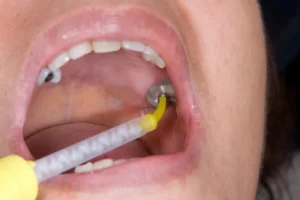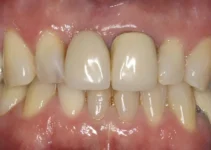A periodontal abscess is a painful dental condition caused when a pocket of pus forms in the tissues of the gums. This type of abscess typically results from an infection that has spread deep beneath the gum line, leading to swelling, discomfort, and potential damage to the surrounding teeth and bones. Common symptoms include severe pain, sensitivity to heat or cold, and swollen gums. If left untreated, a periodontal abscess can lead to more serious complications, including tooth loss and generalized infection. Treatment often involves professional cleaning, drainage of the abscess, and antibiotics to clear the infection. In some cases, surgery may be necessary to prevent recurrence. Prompt treatment by a dental professional is crucial to manage symptoms and prevent further health issues.
Understanding Periodontal Abscess
What is a Periodontal Abscess?
A periodontal abscess is a localized infection within the tissues that surround a tooth. Unlike a periapical abscess, which originates from the tooth pulp, a periodontal abscess forms in the gum pocket. This type of abscess is characterized by a rapid onset, severe pain, and can have serious implications for both your dental and overall health. The infection results in the accumulation of pus, a thick fluid consisting of white blood cells, dead tissue, and bacteria. If left untreated, the abscess can spread to other parts of the body, leading to more severe health complications. Therefore, understanding what a periodontal abscess is, and how to identify it is essential for early intervention and treatment.
Common Symptoms of Periodontal Abscess
The clinical presentation of a periodontal abscess can vary, but there are several common symptoms to be aware of. Pain is typically the most noticeable symptom, often described as intense and throbbing. The pain usually worsens when chewing or touching the affected area.
Other common symptoms include:
- Red, swollen gums
- Bad breath or a foul taste in the mouth
- Fever and general malaise
- Swollen lymph nodes in the neck
Recognition of these symptoms is crucial for timely medical intervention. Early diagnosis can prevent the condition from escalating into a more severe infection or even tooth loss.
Potential Causes of Periodontal Abscess
The causes of periodontal abscesses can be multifactorial. One of the most common causes is poor oral hygiene, which leads to the accumulation of plaque and tartar. These substances harbor bacteria that can infect the gum pockets. Inadequate dental care and missed dental cleanings are significant contributors.
Other potential causes include:
- Gum disease (Periodontitis)
- Trauma to the gums
- Diabetes, which can compromise immune health
- Smoking, which impairs healing
Identifying the root cause of a periodontal abscess is essential for effective treatment and prevention of recurrence. Various studies have shown that maintaining good oral hygiene and regular dental check-ups are vital preventive measures.
Want to know more about how to manage and treat periodontal abscess effectively? Check out our other articles to stay informed and keep your dental health in check.
Diagnosis and Treatment Options
A periodontal abscess is a localized infection within the tissues surrounding the teeth. Timely diagnosis and appropriate treatment are crucial to mitigate complications and preserve oral health. This section delves into the methods used for diagnosis and the various treatment options available.
Proper diagnosis involves a thorough clinical examination, complemented by radiographic imaging. Various treatment methodologies, ranging from nonsurgical procedures to surgical intervention, are employed based on the severity of the abscess and the overall periodontal health of the patient.
How is a Periodontal Abscess Diagnosed?
The diagnosis of a periodontal abscess begins with a comprehensive clinical examination. Dentists assess signs like localized swelling, tenderness, and pus discharge. Visual examination is supported by probing depths, which help determine the extent of the periodontal pocket. Radiographs, particularly periapical and bitewing X-rays, are essential to visualize bone loss and the exact location of the infection.
In addition to clinical and radiographic evaluations, patient history is crucial. Dentists inquire about symptoms such as pain, difficulty chewing, and gum sensitivity. Systemic conditions like diabetes can predispose individuals to periodontal abscesses, thus a holistic health history is taken into account.
Diagnosis may also involve microbiological tests to identify the specific bacteria involved. This can guide antibiotic therapy if necessary. Early diagnosis is key to avoid the spread of infection and potential tooth loss.
Treatment Methods for Periodontal Abscess
Treatment options for a periodontal abscess vary based on the severity and underlying cause of the infection. Some of the primary treatment methods include:
- Drainage and Cleaning: The first line of treatment involves draining the abscess to remove pus, followed by thorough cleaning of the periodontal pocket. This helps to eliminate debris and bacteria from the infected area.
- Scaling and Root Planing: This nonsurgical procedure involves deep cleaning below the gumline to remove plaque and tartar. It is often necessary to manage the infection and prevent recurrence.
- Antibiotic Therapy: In cases of severe infection or systemic involvement, antibiotics may be prescribed to control bacterial proliferation. The choice of antibiotic is based on the specific bacteria identified and patient medical history.
- Surgical Intervention: When nonsurgical treatments are insufficient, surgical procedures like flap surgery or periodontal regeneration may be necessary. These aim to reduce pocket depth and restore supportive tissue.
In addition to these standard treatments, ongoing maintenance and follow-up appointments are critical to monitor healing and prevent future abscesses. Educating patients on good oral hygiene practices and regular dental visits is indispensable.
Understanding the diagnosis and treatment of periodontal abscesses is pivotal for maintaining optimal oral health. For more detailed insights into related dental issues and advanced treatment methodologies, explore our other articles.
Prevention and Long-term Care
Implants and bone regeneration are significant advancements in dental care, but their success largely depends on how well patients adhere to preventive measures and long-term care routines. Preventive measures not only involve the immediate post-surgery phase but also stretch well into the everyday lifestyle of the patient. Ensuring the health of dental implants and regenerated bone structures requires a combination of professional guidance and diligent self-care.
Preventive measures and long-term care are essential for the enduring success of dental implants and bone regeneration. This involves a comprehensive approach that includes both clinical follow-ups and patient-driven care activities. It is imperative for patients to understand that the longevity of their dental investments hinges on their commitment to these measures.
Preventive Measures
Oral hygiene is the cornerstone of preventive care for dental implants and bone regeneration. Proper brushing and flossing techniques must be followed diligently to prevent plaque accumulation, which can lead to peri-implantitis, an inflammatory condition that affects the soft and hard tissues around dental implants. Regular use of antibacterial mouthwash can also be beneficial in reducing microbial load.
- Regular Dental Checkups: It is crucial to have dental checkups at least twice a year. During these visits, dentists can assess the condition of the implants and the surrounding bone structure, ensuring that any early signs of issues are promptly addressed.
- Avoiding Harmful Habits: Activities such as smoking, excessive alcohol consumption, and grinding of teeth can undermine the stability of dental implants. Smokers, in particular, have been shown to have a higher rate of implant failure compared to non-smokers.
Dietary choices also play a role in the maintenance of dental implants. A diet rich in vitamins and minerals supports bone health, while excessive sugar and acidic foods can contribute to the deterioration of oral health. Staying well-hydrated aids in the natural cleansing of the mouth.
Managing Recurrence
Recurrence of dental issues such as bone loss or peri-implantitis is a concern for many patients. Proactive management involves regular monitoring and timely intervention. Advanced imaging techniques like CBCT (Cone Beam Computed Tomography) can help in the early detection of bone density changes around implants.
For patients with a history of periodontal disease, personalized care plans that include more frequent dental visits and specialized cleaning procedures may be necessary. Antimicrobial treatments and adjunctive therapies like laser treatment can help manage and mitigate inflammation.
In some cases, additional regenerative procedures might be required to maintain the longevity of the initial implant. Bone grafting and guided tissue regeneration can be revisited depending on the individual needs of the patient.
Patient education is also key in managing recurrence. Patients should be made aware of the signs of potential complications such as swelling, pain, or mobility of the implant, and should seek dental care promptly if any of these signs are noticed.
Long-term Care
Longevity of dental implants is heavily influenced by the long-term care strategy adopted. It is important for both patients and dental professionals to maintain a proactive approach. Customized care plans that consider the patient’s unique dental history and lifestyle are most effective.
Technological advancements have enabled better tracking and maintenance of dental health. Smart toothbrushes and oral hygiene apps can help patients monitor their daily regimen, ensuring they adhere to recommended practices. These tools can remind patients to follow up on their dental appointments and provide insights into their oral hygiene status.
- Routine X-rays and Assessments: Annual or bi-annual X-rays can assist in tracking the condition of the implant and the surrounding bone. These scans can detect any potential shifts or issues at an early stage.
- Professional Cleanings: Even with meticulous daily care, professional cleanings are essential. Special tools and techniques used by dental professionals can clean areas that are difficult to reach with standard home care.
Long-term care also extends to the use of custom mouthguards for patients who grind their teeth or engage in high-impact activities. These guards can protect the implants from mechanical stresses that could otherwise lead to failure. Protecting your dental investments with thoughtful, consistent care ensures that they remain functional and effective for years to come.
For a more comprehensive understanding of dental implants, bone regeneration, and other dental care topics, feel free to explore other articles in our series.
Common Questions About Periodontal Abscess
If you are looking for more details on periodontal abscesses, here are some common questions and answers to help enhance your understanding of this dental condition.
What is a periodontal abscess and how does it differ from other dental abscesses?
A periodontal abscess is a localized infection that occurs within the gums. It is specifically located in the periodontal pocket, which results from severe gum disease (periodontitis). Unlike a periapical abscess that occurs at the root tip of a tooth usually due to an infection within the tooth itself, a periodontal abscess is the infection of the gum tissue due to the spread of bacteria along the exterior surfaces of the tooth’s root.
What are the common symptoms of a periodontal abscess?
The most notable symptoms of a periodontal abscess include severe, persistent pain; swelling in the gums; redness around the affected area; and the presence of pus. This type of abscess can also lead to a bad taste or odor in the mouth. Sometimes, it may cause gum recession or the development of a new gap between teeth if the abscess progresses significantly.

My name is Salman Kapa, a 73-year-old expert in bone regeneration and dental implantology. With decades of experience in the field, I am dedicated to advancing our understanding of oral health and hygiene. Through my research and writing, I aim to contribute to the development of innovative solutions in dental care.




